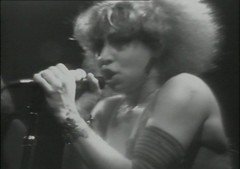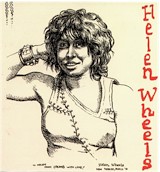Pat Ivers and Emily Armstrong continue sorting through their archives of punk-era concert footage as it’s digitized for the Downtown Collection at N.Y.U.’s Fales Library.
“I could describe her to you in details, but those are just facts. She was unforgettable, and everybody who knew her, loved her.”
That was Scott Kempner of The Dictators and the Del-Lords describing Helen Wheels, a woman who to the mainstream may seem like a punk rock history footnote, but who to CBGB veterans was a beloved icon.
Standing just over five feet tall, Helen embodied the tough, take-no-prisoners front-woman before Heart, Joan Jett or Pat Benatar made it acceptable. With tattoos, muscles and a friendship with the Hells Angels, she broke the mold, even for CBGBs. She claimed the beloved python, Lilith, was the largest privately-owned reptile in New York.
Helen got her start in the music scene early. While a student at Stony Brook in 1968, she met Blue Oyster Cult, then known as Soft White Underbelly. She moved into a house with them on Long Island and was soon designing their leather clothing and writing lyrics for their songs.
Scott Kempner remembers, “I met her when The Dictators were rehearsing at the Fillmore East in 1974 — we were friends with BOC, we had the same management, it was like one big family.” Helen had been writing songs for herself, and when The Dictators lost their record deal in 1976, some of the guys signed on as her backup band. It was fun, but that first iteration of the Helen Wheels Band ended when a freak accident involving the collapse of a wall in their rehearsal space destroyed their instruments.
Helen moved on. She auditioned more musicians and in this clip from 1979 at CBGBs, Kempner rejoins her after another Dictators’ breakup. “For me, it was life changing. She encouraged me to write songs and play lead, that’s the kind of person she was. So generous,” he said.
But it was hard to keep a band going. The members kept changing and so did the environment. As she told Rocker Girl in an interview, “It was a dangerous scene, there was so much heroin that punk became confused with the junkie scene.”
The breakup of the Sex Pistols convinced big record labels that punk was not a viable commodity. Helen self-released an EP in 1981, but without major-label support, it received little airplay.
She began body building. Through the ’80s, she won three Regional First Place Lightweight titles and a Women’s Masters Championship. But when she left New York City for upstate Ithaca in 1996, she gave up competitive body building because she felt that steroids had ruined the sport.
She never gave up on her music, though. In 1998, Helen released an album, “Archetype,” a compilation of her recordings produced by BOC’s Albert Bouchard and rock writer Deborah Frost. Frost recalls, “I think it gave her a feeling of completion hearing all those songs together. The cover art was her portrait by R. Crumb, who of course, was her fan and friend. And she had a new band, Skeleton Crew. She never quit.”
In 1999, Helen started working on a book about the punk scene with photographer Mariah Aguiar, “We Took Dawn for Granted.” A few months later, an old back injury led her to take a break and enter the hospital for corrective back surgery. After her release, she developed an infection and fell into a coma. She was readmitted and put on a ventilator, but died shortly after.
That will be twelve years ago next week. The book was never completed; her collaborator Mariah also passed away. Their families are hoping to finally publish it soon.
“I miss her,” Scott Kempner told us. “She had the biggest smile.”






